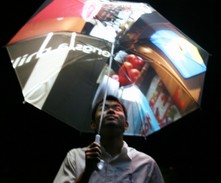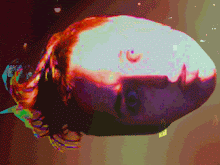Monday, November 20, 2006
Russell
LiveNet
Incorporating new healthcare technologies for proactive health and elder care will become a major priority over the next decade, as medical care systems world-wide become strained by aging populations. The LiveNet platform is a flexible distributed mobile system that can be deployed for a variety of proactive health applications that can help reduce the strain on the healthcare industry. LiveNet enables a variety of large-scale wireless group applications by leveraging the availability of Linux-based PDA hardware combined with innovative open-source software and custom sensor hardware. The LiveNet system is based on the MIThril 2003 architecture, a proven accessible architecture that combines inexpensive commodity hardware, a flexible sensor/peripheral interconnection bus, and a powerful light-weight distributed sensing, classification, and inter-process communications software layer to facilitate the development of distributed real-time multimodal and context-aware applications. LiveNet also opens up the door for practical long-term continuous monitoring applications to identify physiological and behavioral trends that vary slowly with time. The system can also allow people to receive real-time feedback from their continuously monitored and analyzed health state, as well as communicate health information with care-givers and other members of an individual's social network for support and interaction.
Cait
GroupMedia is a set of tools and applications to enable social context awareness and quantitative intelligence on pervasive cell phones and PDAs. By building quantitative models of human behavior and social interaction, we can devise next generation social software for the wearable devices.
Reality Mining
The Reality Mining experiment is one of the largest academic mobile phone projects in the US. Our research agenda takes advantage of the increasingly widespread use of mobile phones to provide insight into the dynamics of both individual and group behavior. By leveraging recent advances in machine learning we are building generative models that can be used to predict what a single user will do next, as well as model behavior of large organizations.
Keith
Learning Humans
The purpose of this set of projects is to develop techniques for learning human behavior in an office or a social situation. Projects include learning both human control and interactive behaviors. We want to build machines that understand person's intentions by the set of subtle queues and patterns of his regular behavior. This will help to seamlessly integrate computers into our everyday lives.
Expression of personal self through clothing
Whisper
Similarly, Whisper, [http://whisper.surrey.sfu.ca/index2.html] another large collaborative project headed by Vancouver-based media artists Thecla Schiphorst and Susan Kozel (and involving numerous other artists, designers, computer scientists, and hardware/software engineers) uses skin as the metaphor for the boundary between external and internal relations, bringing the activity contained within individual bodies out into a shared domain. Whisper is a set of networked garments that track physiological data such as heart rate, galvanic skin response, and breathing patterns. Biometric sensors are embedded in the garments, and these trigger different visual and auditory display patterns - both on the clothing (via LEDs embedded in the sleeve, for example), and throughout the environment (via video projection and audio speakers). Individuals wearing the Whisper garments can decide what data to share, and with whom. Like TGarden, the Whisper project creates a liminal area of activity within which participants can focus on their incoming bodily sensations. It also serves as a testing ground for modes of interaction with the potential to integrate emotive and intimate elements into the network communications of the future.
Medulla Intimata
Whereas TGarden and Whisper construct installation environments within which particular garments function, other artists choose to work with the syntax of everyday activity in its natural setting. In Medulla Intimata, [www.thisisclutch.com/medulla.html] a project by Tina Gonsalves and Tom Donaldson, galvanic skin response drives a small video screen embedded in a piece of jewelry. Designed to look like "normal" jewelry, the project consists of a deliberately ostentatious necklace. The video display consists of the wearer's image - but, depending on the affective input of the wearer (biometric measurements of their emotional state, or the dynamics or tone of their conversations), the video doppelganger expresses contradictory or unintentionally revealing emotions. The uncontrollability of this alter-ego highlights the dual nature of one's public persona and private emotions, creating an accessory which disrupts conditioned ways of presenting the self. The artists refer to Medulla Intimata as both a "foil" to the wearer and, perhaps most tellingly, a "wound" - for its expression of the way repressed and hidden emotions can leak into the managed world of "polite" conversation, creating undercurrents of unspoken thoughts and accusations. In most cases, wearable computing applications attempt to assist the individual in covering such lapses. Medulla Intimata posits instead that these small, everyday deceptions might be propelled toward a forced reckoning by a fashion accessory. Ultimately, the artists are asking whether a greater control over, or ability to manage, perceptions is indeed better in the end.
Seven Mile Boots
In the case of Seven Mile Boots, [http://randomseed.org/sevenmileboots/] it is precisely a lack of control that provides a sense of excitement and discovery. Laura Beloff and her collaborators Erich Berger and Martin Pichlmair have created a pair of shoes that allow for physical wandering through virtual space. Deriving their title from a folktale about a pair of boots which allow the wearer to walk seven miles with one step, the striking red shoes allow the wearer to cross vast distances on the Internet by browsing through active chatrooms while the wearer walks. A text-to-speech engine broadcasts the contents of the online conversations out loud, allowing the wearer of the boots to eavesdrop on them while stationary. The wearer does not know where each step will take them, yet a sense of opportunity and surprise springs to the fore as the person becomes, in the artists' words, a "digital flaneur". In likening online Internet chatrooms to the urban spatiality of the city, Beloff and her collaborators present a novel method of browsing information, and create a compelling relationship between the activity of the online world and the physical world surrounding our bodies. The open channels that the boots create are referred to as "holes" that provide vantage points from which to view distant activity - and yet, these connections also become ingrained in the individual wearer's identity and experience.
Friday, September 22, 2006
Open source prosthetics movement

"Quinn Norton's written a stupendous piece for Wired News on a new open-source prosthetics movement started by a Iraq-war veteran upper-arm amputee named Jonathan Kuniholm, who has vowed to produce a prosthesis "that's so cool, somebody with two arms would want an amputation to get one."
The Open Prosthetics Project
Kuniholm was an engineer before his Marine reserve unit was sent to Iraq, where he lost his arm to an IED. His engineer/design partners in North Carolina worked with him to improve the nonfunctional smooth plastic prosthesis he was issued by the VA, making substantial improvements over the basic design. Then they decided to open up the designs to help other amputees. The site has grown into a collection of prosthesis hacks that includes mounting a Spider Man fishing rod on a child's prosthetic arm.
All this week, Garry Trudeau has been running a Doonesbury series about BD, the football jock/veteran amputee just back from Iraq, who goes to a tattoo parlor motorcycle shop with his prosthetic leg to get the man there to "pimp his gimp."
Founded last year, the nonprofit Open Prosthetics Project applies the ethical and intellectual property foundation of open-source software to the task of building better artificial limbs. The project releases its experimental designs to its website in the public domain, free for anyone to use, forever. Anyone can download the STL files, tinker with them in CAD software, and submit them to a rapid manufacturer, such as a prototyping 3-D printing company.
This lets anyone turn out a customized prosthetic device without incurring tens of thousands of dollars in production costs. A user with a few hundred dollars to spend can be holding the physical reality within a week, though the post processing would still require some expertise...
Open Prosthetics' experimental design incorporates both modes in one hook, using a pin/spring/cam set-up controlled by the intensity of the wearer's shrug: A limited shrug momentarily opens or closes the hook, just like the traditional design, while a full shrug acts as a toggle, reversing the hook from open to closed, or visa versa, and leaving it there until the next actuation.
They've built and rebuilt two versions of this positional hook, and they have a working prototype of the entire limb made from LEGO Technic parts. (This video demonstrates the strength difference of the two modes in picking up a small object.)"
http://www.wired.com/news/technology/0,71797-0.html
boingboing.net
GPS
wikipedia.org
Wordnet
adj : capable of being traced or tracked; "a traceable riverbed"; "the traceable course of an ancient wall"
Wearable Computer - definition

Wearable computers are computers that are worn on the body. They have been applied to areas such as behavioral modeling, health monitoring systems, information technologies and media development. Government organizations, military, and health professionals have all incorporated wearable computers into their daily operations. Wearable computers are especially useful for applications that require computational support while the user's hands, voice, eyes or attention are actively engaged with the physical environment.
wikipedia.org
Wearable Computing - MIT
"To date, personal computers have not lived up to their name. Most machines sit on the desk and interact with their owners for only a small fraction of the day. Smaller and faster notebook computers have made mobility less of an issue, but the same staid user paradigm persists. Wearable computing hopes to shatter this myth of how a computer should be used. A person's computer should be worn, much as eyeglasses or clothing are worn, and interact with the user based on the context of the situation. With heads-up displays, unobtrusive input devices, personal wireless local area networks, and a host of other context sensing and communication tools, the wearable computer can act as an intelligent assistant, whether it be through a Remembrance Agent, augmented reality, or intellectual collectives."
Umbrella shows a Flickr stream on the inside surfaces

"A project in the handle of the Pileus umbrella paints the brolly's interior with a series of wirelessly-fetched Flickr photos while a camera in its tip lets you document your day.
The system is constructed by the Pileus Umbrella and the Pileus WebService. User can see and take a photo and video with the PileusUmbrella. User can hand on own experience in rainy day to next user with an umbrella type photoset. User Connects the Grip with the Screen, then the Grip reads the Screen’s ID and login to own Pileus Account. When user takes photos or videos, Pileus WebService evaluates media-type of data and uploads it to Flickr or YouTube, and then set a tag by screen ID. In addition, user twists the grip, it searchs contents at Flickr and YouTube by tag of screen ID, and displays contents in order."
boingboing.net



